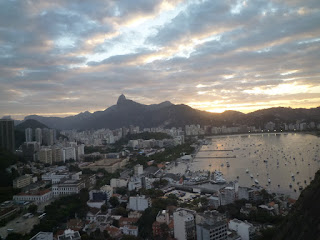 The Apurimac river canyon
The Apurimac river canyon
Choquequirao: a completely unobstructed picture of the site
I'm back from my trek in Peru and it was fantastic. I spent 5 days walking 64 kms, going through incredible landscapes, including a double-crossing of the Apurimac canyon to reach the Inca site of Choquequirao (1600 m of vertical drop going down, then up, then down and up again on the way back). This is the only way to reach the site if you are not Alan Garcia Perez - the Peruvian president - who comes regularly using a chopper, and as a result, there are very few visitors there, which makes the visit an incredible experience. During the 2 days our group of 4 visited the site, we met only a couple of frenchies and a small group of Peruvians studying to become guides. This contrasts with the 2000 to 3000 persons a day visiting Machu Picchu! This was incredible to spend hours walking through the site with no other people present. The site itself is currently smaller than Machu Picchu although archeologists believe they were approximately the same size before vegetation took over in Choquequirao. There is a team of 40 archeologists working on the site presently, trying to find and restore the 60% that are believed to be covered by the jungle. Their latest discovery, in 2004, was the Llama terrasses, a series of terrasses used for agriculture and decorated with Llamas.
It may seem like a crazy idea to build a city in a place so remote, at 3100 m of altitude, and I think it is. But the Quechuas (the real name of the people from this civilization - Inca was the name of the king) did not mind the altitude, the effort to get there, and these sites (Machu Picchu included) were believed to be both religious centers (and they had to be as close as the sun, Inti, the true God, as they could) and military centers that established dominance over the region, a little like castles that can be found all over Europe.
 The Llama terrasses in Choquequirao, discovered in 2004
The Llama terrasses in Choquequirao, discovered in 2004
Even if this experience was everything I needed, I still had to visit Machu Picchu, a wonder of the world and a must-do in South America. I am a little torn because the site is well preserved (all of the city is uncovered and visible) and it is incredibly beautiful, but access to the site is so easy (trains and buses bring an incessant flow of tourists every hour, all day-long) that it has become a very crowded place - archeologists consider that the number of visitors should be limited to no more than 500 per day to limit the slow destruction of the site that has already begun. In sum, I had two very different experiences visiting two beautiful sites, and I would not change a thing if I had to do it again.
Now I am back to Bolivia for a while before finishing my trip in Brazil. Three months are definitely not enough to visit this incredible continent, so I will have to keep making choices...
The site of Machu Picchu (old mountain) and the Wayna Picchu (young mountain) in the background
 Sunset on the beautiful city of Rio from the Pão de Açùcar
Sunset on the beautiful city of Rio from the Pão de Açùcar 
















